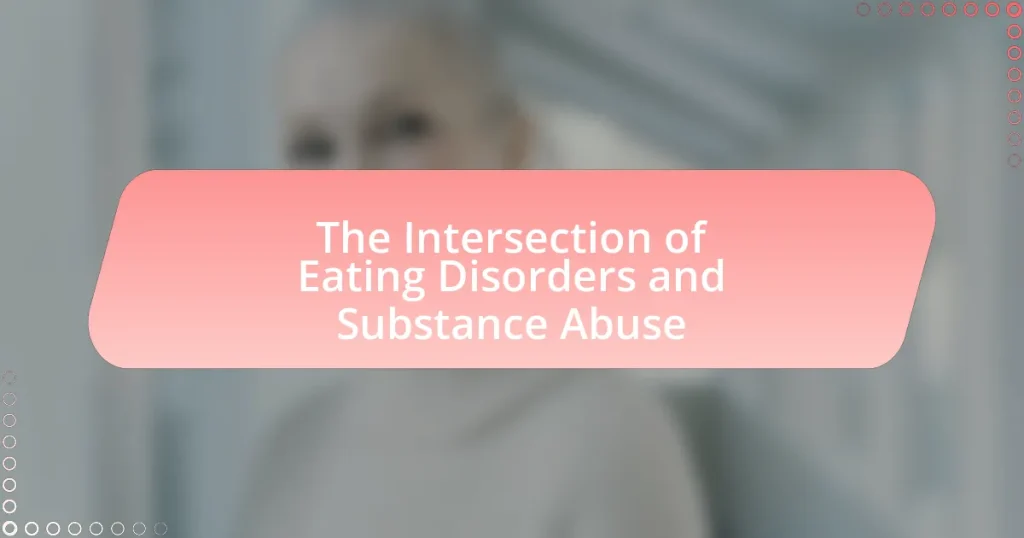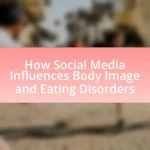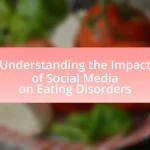Eating disorders and substance abuse are interconnected psychological conditions that significantly impact individuals’ health and daily functioning. Research indicates that approximately 50% of individuals with eating disorders, such as anorexia nervosa and bulimia nervosa, also struggle with substance use disorders, highlighting the complex relationship between these issues. The article explores the definitions, types, symptoms, and treatment options for both eating disorders and substance abuse, emphasizing the importance of integrated treatment approaches that address both conditions simultaneously. It also discusses the psychological and societal factors contributing to their co-occurrence, the role of nutrition in recovery, and the significance of support systems for individuals and families affected by these disorders.

What are Eating Disorders and Substance Abuse?
Eating disorders are psychological conditions characterized by abnormal eating habits that negatively impact health, emotions, and daily functioning, while substance abuse refers to the harmful or hazardous use of psychoactive substances, including alcohol and illicit drugs. Research indicates that individuals with eating disorders, such as anorexia nervosa or bulimia nervosa, often have a higher prevalence of substance abuse, with studies showing that approximately 50% of individuals with eating disorders also struggle with substance use disorders. This intersection highlights the complex relationship between these two issues, where one can exacerbate the other, leading to more severe health consequences.
How are Eating Disorders defined?
Eating disorders are defined as serious mental health conditions characterized by abnormal eating habits that negatively impact physical and emotional health. These disorders include conditions such as anorexia nervosa, bulimia nervosa, and binge-eating disorder, each marked by specific behaviors and psychological issues related to food intake, body image, and weight. According to the National Eating Disorders Association, approximately 30 million Americans will experience an eating disorder in their lifetime, highlighting the prevalence and seriousness of these conditions.
What are the different types of Eating Disorders?
The different types of eating disorders include anorexia nervosa, bulimia nervosa, binge-eating disorder, and other specified feeding or eating disorders (OSFED). Anorexia nervosa is characterized by extreme restriction of food intake and an intense fear of gaining weight. Bulimia nervosa involves cycles of binge eating followed by compensatory behaviors such as vomiting or excessive exercise. Binge-eating disorder is marked by recurrent episodes of eating large quantities of food without subsequent purging behaviors. OSFED encompasses a range of eating disorders that do not meet the specific criteria for the aforementioned disorders but still cause significant distress or impairment. According to the National Eating Disorders Association, these disorders affect millions of individuals and can lead to severe health complications if left untreated.
What are the common symptoms of Eating Disorders?
Common symptoms of eating disorders include significant weight loss or gain, preoccupation with food, body weight, and shape, as well as extreme dieting or binge eating behaviors. Individuals may also exhibit physical signs such as changes in skin, hair, and dental health, along with gastrointestinal issues. Psychological symptoms often involve anxiety, depression, and social withdrawal. Research indicates that these symptoms can lead to severe health complications, including heart problems and malnutrition, highlighting the critical nature of early intervention and treatment.
How is Substance Abuse characterized?
Substance abuse is characterized by a compulsive pattern of using drugs or alcohol despite negative consequences. This behavior often leads to physical dependence, tolerance, and withdrawal symptoms, indicating a significant disruption in an individual’s daily functioning and health. According to the National Institute on Drug Abuse, approximately 19.7 million adults in the United States battled a substance use disorder in 2017, highlighting the widespread impact of this issue.
What substances are commonly abused?
Commonly abused substances include alcohol, prescription opioids, cocaine, methamphetamine, and marijuana. Alcohol is frequently misused due to its legal status and social acceptance, with the National Institute on Alcohol Abuse and Alcoholism reporting that approximately 14.5 million adults in the U.S. had Alcohol Use Disorder in 2019. Prescription opioids, such as oxycodone and hydrocodone, are often abused for their pain-relieving properties, leading to significant addiction rates, as indicated by the Centers for Disease Control and Prevention, which noted that nearly 70% of drug overdose deaths in 2019 involved an opioid. Cocaine and methamphetamine are stimulants that are commonly abused for their euphoric effects, with the Substance Abuse and Mental Health Services Administration reporting millions of users in the U.S. Lastly, marijuana remains one of the most widely used illicit drugs, with a growing number of states legalizing its use, contributing to its prevalence in substance abuse statistics.
What are the signs of Substance Abuse?
Signs of substance abuse include changes in behavior, physical health issues, and social withdrawal. Individuals may exhibit mood swings, increased secrecy, and neglect of responsibilities. Physical signs can manifest as weight fluctuations, poor hygiene, and frequent nosebleeds, particularly with cocaine use. Socially, individuals may isolate themselves from friends and family, lose interest in activities they once enjoyed, and experience relationship problems. According to the National Institute on Drug Abuse, these signs can indicate a growing dependency on substances, which can lead to severe health and social consequences.
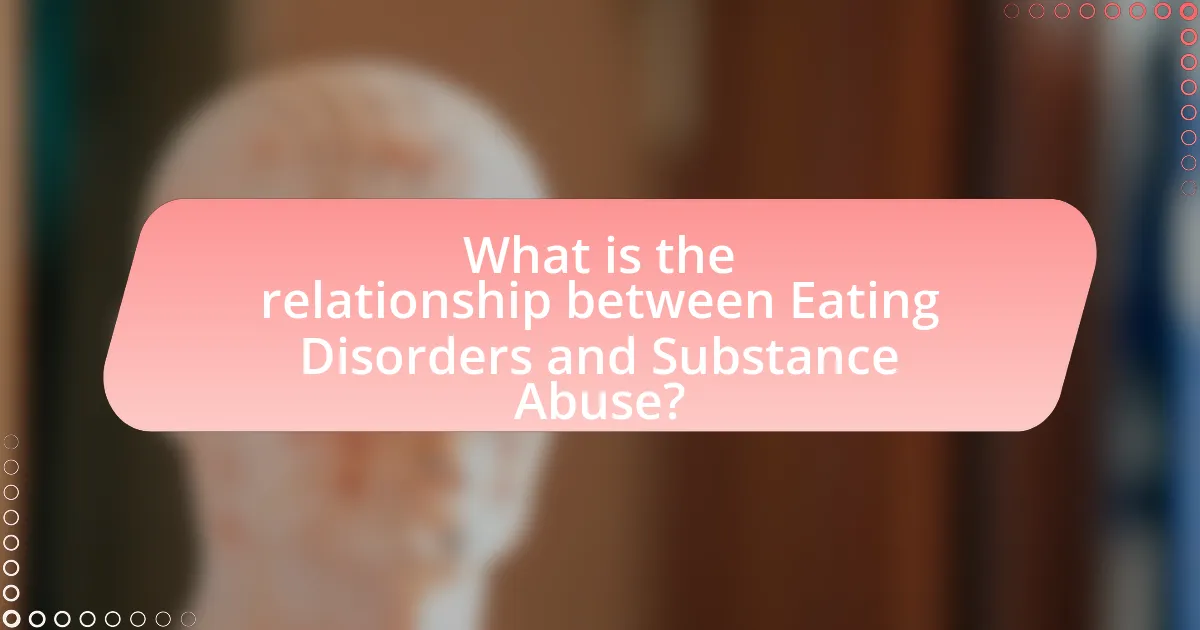
What is the relationship between Eating Disorders and Substance Abuse?
Eating disorders and substance abuse are closely related, often co-occurring in individuals. Research indicates that individuals with eating disorders may use substances as a means to control weight, cope with emotional distress, or enhance the effects of restrictive eating behaviors. For instance, a study published in the Journal of Eating Disorders found that approximately 50% of individuals with anorexia nervosa also have a history of substance abuse, particularly alcohol and stimulants. This relationship highlights the complex interplay between psychological factors, body image issues, and the use of substances as maladaptive coping mechanisms.
How do Eating Disorders and Substance Abuse co-occur?
Eating disorders and substance abuse co-occur due to overlapping psychological, biological, and social factors. Individuals with eating disorders may use substances to control weight, suppress appetite, or cope with emotional distress, while those with substance abuse issues may develop eating disorders as a result of altered metabolism or nutritional neglect. Research indicates that approximately 50% of individuals with eating disorders also struggle with substance use disorders, highlighting a significant correlation between the two conditions. This co-occurrence can exacerbate health risks, complicate treatment, and lead to poorer outcomes for affected individuals.
What are the psychological factors linking Eating Disorders and Substance Abuse?
The psychological factors linking eating disorders and substance abuse include low self-esteem, trauma, and the desire for control. Individuals with eating disorders often experience negative body image and feelings of inadequacy, which can lead to substance use as a coping mechanism. Research indicates that both conditions share underlying issues such as perfectionism and emotional dysregulation, which can exacerbate the severity of each disorder. For example, a study published in the Journal of Eating Disorders found that individuals with bulimia nervosa are at a higher risk for developing substance use disorders, highlighting the interconnectedness of these psychological factors.
How do societal pressures influence both Eating Disorders and Substance Abuse?
Societal pressures significantly influence both eating disorders and substance abuse by creating unrealistic standards of beauty and success that individuals feel compelled to meet. These pressures often manifest through media portrayals, peer expectations, and cultural norms that equate thinness or substance use with desirability and acceptance. Research indicates that individuals exposed to these societal ideals are at a higher risk for developing eating disorders, such as anorexia and bulimia, as they strive to conform to these unattainable standards. Similarly, the desire to fit in or cope with stressors related to societal expectations can lead to increased substance use, as individuals may turn to drugs or alcohol as a means of escape or social acceptance. A study published in the Journal of Eating Disorders found that 70% of individuals with eating disorders reported feeling pressure to conform to societal beauty standards, while the National Institute on Drug Abuse highlights that social influences are a significant factor in the initiation and continuation of substance use.
Why is it important to understand their intersection?
Understanding the intersection of eating disorders and substance abuse is crucial because both conditions often co-occur and can exacerbate each other, leading to more severe health consequences. Research indicates that individuals with eating disorders are at a higher risk for developing substance use disorders, with studies showing that approximately 50% of individuals with anorexia or bulimia also struggle with substance abuse issues. This overlap complicates treatment, as addressing one disorder without considering the other can hinder recovery and increase the likelihood of relapse. Therefore, recognizing their intersection allows for more effective, integrated treatment approaches that address the complexities of both conditions simultaneously.
What are the implications for treatment and recovery?
The implications for treatment and recovery in the context of the intersection of eating disorders and substance abuse are significant, as both conditions often co-occur and can exacerbate each other. Effective treatment must address both issues simultaneously, as failure to do so can lead to poor outcomes. Research indicates that integrated treatment approaches, which consider the psychological, nutritional, and substance use aspects, are more effective than traditional methods that treat each disorder separately. For instance, a study published in the Journal of Substance Abuse Treatment found that individuals receiving integrated care showed higher rates of recovery and lower relapse rates compared to those receiving sequential treatment. This highlights the necessity for healthcare providers to adopt a holistic approach in order to improve recovery outcomes for individuals facing both eating disorders and substance abuse.
How can awareness improve outcomes for individuals affected?
Awareness can significantly improve outcomes for individuals affected by eating disorders and substance abuse by facilitating early intervention and reducing stigma. Increased awareness leads to better recognition of symptoms, enabling individuals and their families to seek help sooner, which is crucial for effective treatment. For instance, studies show that early intervention in eating disorders can lead to recovery rates as high as 70-90% when treated within the first year of onset. Furthermore, awareness campaigns can educate the public about the co-occurrence of these issues, promoting understanding and empathy, which can encourage individuals to seek support without fear of judgment. This dual approach of early recognition and stigma reduction ultimately enhances recovery prospects and overall well-being for those affected.
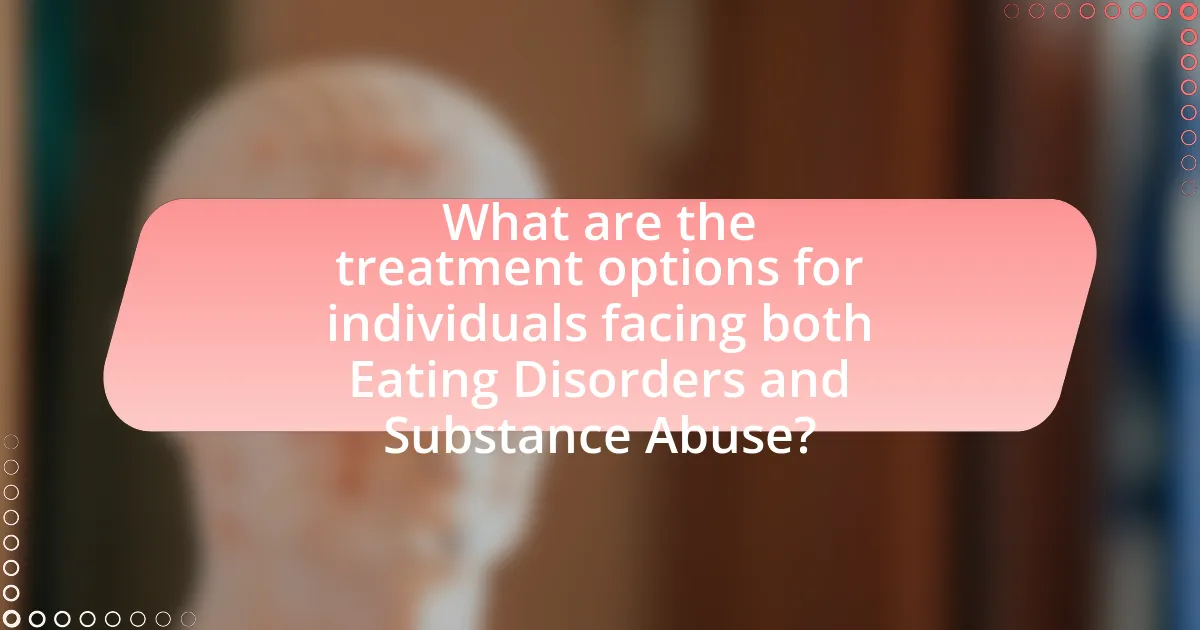
What are the treatment options for individuals facing both Eating Disorders and Substance Abuse?
Individuals facing both Eating Disorders and Substance Abuse can benefit from integrated treatment approaches that address both conditions simultaneously. Evidence-based options include cognitive-behavioral therapy (CBT), which has been shown to effectively treat both disorders by modifying harmful thought patterns and behaviors. Additionally, dialectical behavior therapy (DBT) is beneficial for managing emotional dysregulation often present in these individuals.
Research indicates that a comprehensive treatment plan may also involve nutritional counseling to restore healthy eating patterns and medical management to address any physical health issues arising from both disorders. A study published in the Journal of Substance Abuse Treatment highlights that integrated treatment leads to better outcomes compared to sequential treatment, emphasizing the importance of addressing both issues concurrently for effective recovery.
What integrated treatment approaches are available?
Integrated treatment approaches for eating disorders and substance abuse include cognitive-behavioral therapy (CBT), dialectical behavior therapy (DBT), and integrated group therapy. These approaches are designed to address both conditions simultaneously, recognizing the interplay between them. Research indicates that CBT effectively targets the cognitive distortions associated with both eating disorders and substance use, while DBT provides skills for emotional regulation and interpersonal effectiveness, which are crucial for individuals facing these dual challenges. Integrated group therapy fosters a supportive environment where individuals can share experiences and coping strategies, enhancing recovery outcomes.
How do therapeutic interventions address both issues simultaneously?
Therapeutic interventions address both eating disorders and substance abuse simultaneously by employing integrated treatment approaches that target the underlying psychological and behavioral issues common to both conditions. These interventions often include cognitive-behavioral therapy (CBT), which has been shown to effectively modify harmful thought patterns and behaviors associated with both disorders. Research indicates that individuals with co-occurring eating disorders and substance abuse benefit from therapies that address their unique needs, such as dialectical behavior therapy (DBT), which enhances emotional regulation and coping strategies. By focusing on the interconnectedness of these issues, therapists can create a comprehensive treatment plan that improves overall outcomes, as evidenced by studies demonstrating higher recovery rates in patients receiving integrated care compared to those treated for each disorder separately.
What role does nutrition play in recovery from both conditions?
Nutrition plays a critical role in recovery from both eating disorders and substance abuse by providing essential nutrients that support physical and mental health. Adequate nutrition helps restore bodily functions, improves mood, and enhances cognitive abilities, which are often compromised in individuals suffering from these conditions. Research indicates that a balanced diet can lead to better treatment outcomes, as it aids in the stabilization of mood and reduction of cravings associated with substance use disorders. For instance, a study published in the journal “Nutrients” highlights that micronutrient deficiencies are common in individuals with eating disorders and can exacerbate psychological symptoms, making recovery more challenging. Therefore, proper nutrition is fundamental in addressing the physiological and psychological aspects of recovery from both eating disorders and substance abuse.
What support systems can aid recovery?
Support systems that can aid recovery from eating disorders and substance abuse include therapy, support groups, and family involvement. Therapy, particularly cognitive-behavioral therapy (CBT), has been shown to effectively address both issues by helping individuals change harmful thought patterns and behaviors. Support groups, such as those offered by organizations like Alcoholics Anonymous and Eating Disorders Anonymous, provide a community of individuals facing similar challenges, fostering shared experiences and encouragement. Family involvement is crucial as it can create a supportive home environment, which research indicates significantly enhances recovery outcomes. Studies show that integrated treatment approaches that involve both mental health and substance abuse professionals lead to better recovery rates, highlighting the importance of a comprehensive support system.
How can family and friends contribute to the recovery process?
Family and friends can significantly contribute to the recovery process by providing emotional support, fostering a positive environment, and encouraging professional treatment. Emotional support from loved ones helps individuals feel understood and less isolated, which is crucial in recovery from eating disorders and substance abuse. A positive environment, free from judgment and criticism, promotes healthy behaviors and reinforces the individual’s commitment to recovery. Encouragement to seek and adhere to professional treatment, such as therapy or support groups, can enhance the effectiveness of recovery efforts. Research indicates that social support is a key factor in successful recovery outcomes, highlighting the importance of family and friends in this process.
What resources are available for individuals and families?
Individuals and families can access various resources to address the intersection of eating disorders and substance abuse. These resources include support groups, such as the National Eating Disorders Association (NEDA) and Alcoholics Anonymous (AA), which provide community support and guidance. Additionally, treatment facilities specializing in dual diagnosis offer integrated care for both conditions, such as the Center for Discovery and the Renfrew Center. Research indicates that comprehensive treatment approaches improve recovery outcomes, as highlighted in studies published in the Journal of Substance Abuse Treatment. These resources are crucial for fostering recovery and providing necessary support for affected individuals and their families.
What are some best practices for managing Eating Disorders and Substance Abuse?
Best practices for managing eating disorders and substance abuse include integrated treatment approaches that address both issues simultaneously. Research indicates that individuals with co-occurring disorders benefit from therapies that target the psychological, behavioral, and nutritional aspects of both conditions. For instance, cognitive-behavioral therapy (CBT) has shown effectiveness in treating both eating disorders and substance use disorders by helping individuals identify and change harmful thought patterns and behaviors. Additionally, nutritional counseling can provide essential support in restoring healthy eating habits while addressing substance use. A study published in the Journal of Substance Abuse Treatment found that integrated treatment models significantly improve outcomes for individuals facing both challenges, highlighting the importance of a comprehensive approach that includes medical, psychological, and social support.
How can individuals develop healthy coping strategies?
Individuals can develop healthy coping strategies by engaging in mindfulness practices, seeking social support, and utilizing cognitive-behavioral techniques. Mindfulness practices, such as meditation and deep-breathing exercises, help individuals become more aware of their thoughts and feelings, reducing stress and promoting emotional regulation. Research indicates that mindfulness can significantly decrease symptoms of anxiety and depression, which are often linked to eating disorders and substance abuse. Seeking social support from friends, family, or support groups provides individuals with a network to share experiences and gain encouragement, which has been shown to improve resilience and coping skills. Cognitive-behavioral techniques, including identifying negative thought patterns and replacing them with positive affirmations, empower individuals to manage their emotions effectively. Studies have demonstrated that cognitive-behavioral therapy is effective in treating both eating disorders and substance abuse, highlighting its role in developing healthy coping strategies.
What lifestyle changes can support recovery and well-being?
Adopting a balanced diet, engaging in regular physical activity, and practicing mindfulness can significantly support recovery and well-being. A balanced diet provides essential nutrients that help restore physical health, while regular exercise has been shown to improve mood and reduce anxiety, which are crucial for individuals recovering from eating disorders and substance abuse. Mindfulness practices, such as meditation and yoga, can enhance emotional regulation and reduce stress, further aiding recovery. Research indicates that these lifestyle changes contribute to improved mental health outcomes, as evidenced by a study published in the Journal of Substance Abuse Treatment, which found that individuals who incorporated physical activity and mindfulness into their recovery plans reported lower relapse rates and better overall well-being.
